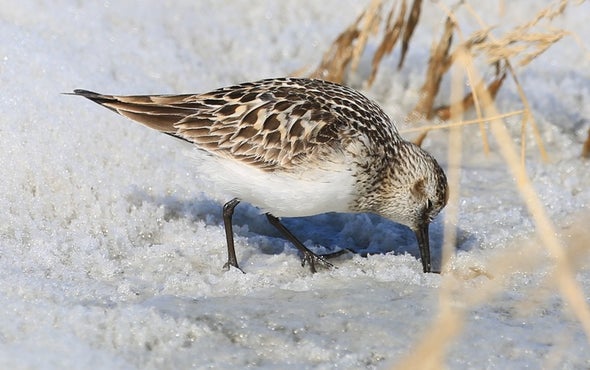Greenland and Arctic record cold and snow are once again being blamed on “climate change,” according to an article in Scientific American. The July 13 article declares a “Lost Summer for Greenland” as “a record late snowpack—lingering into July” harms the shorebirds breeding season. Jeroen Reneerkens, an avian ecologist at the University of Groningen who has studied Greenland’s shorebirds since 2003, expressed bewilderment at the winter conditions in summer. “The tundra was 100 percent covered in snow, and it was a very deep layer,” he says, estimating an average depth of about one meter. “It was a big shock to see the place like that,” he added. (Related article: GLOBAL COOLING: GLOBAL TEMPS HAVE DROPPED BY 0.65C (1.2F DEGREE) SINCE 2016)
The article reported: “This year broke all records,” Reneerkens says. “I know my literature about Arctic shorebirds very well and I have never come across something like this.” He is uncertain how this “disastrous” incident will affect the overall populations of these shorebird species. But “given the scale that this happening [on],” he says, “I do expect that this will have large consequences.” He estimates the record-late snowmelt impacted half of the global breeding area for sanderlings, red knots and ruddy turnstones.

And it’s not just Greenland experiencing a year without a summer. According to Scientific American, “Researchers elsewhere in the Arctic are also reporting unusually late snowmelt this year, with repercussions for shorebirds.
How does Scientific American account for the “lost summer for Greenland”? The article blames “climate change” for the record cold and snow. “Senner fears this nonbreeding year in eastern Greenland could herald an alarming trend. Climate models predict the Arctic atmosphere will hold more moisture as global temperatures rise, he notes. A wetter atmosphere means more snow in winter and spring, potentially causing late snowmelt to interfere with shorebird reproduction,” the article reported.
Article excerpt:
Scientific American: Late Snowpack Signals a Lost Summer for Greenland’s Shorebirds
Sanderlings, red knots and ruddy turnstones failed to breed this year along the Arctic island’s east coast due to record snow coverBy Daniel Ackerman on July 13, 2018
Excerpts: Snowmelt usually allows shorebirds to begin nesting on eastern Greenland’s treeless tundra during the first half of June, says Jeroen Reneerkens, an avian ecologist at the University of Groningen who has studied these birds since 2003. However, when he arrived this year at Zackenberg Station on June 14 to survey sanderlings, a species of Arctic-breeding shorebird, he found they had nowhere to construct their nests. “The tundra was 100 percent covered in snow, and it was a very deep layer,” he says, estimating an average depth of about one meter. “It was a big shock to see the place like that,” he adds…
The region’s tundra was still 80 percent covered in snow as of July 10, according to observations provided by a staff member at Zackenberg…Climatic challenges like late snowmelt in their breeding grounds only compound the birds’ plight… “A nonbreeding year is pretty extreme.” Senner says the case is reminiscent of 1992, when shorebirds suffered poor reproductive success after Mount Pinatubo in the Philippines erupted the prior year. The tropical volcano belched atmosphere-cooling particles over the planet—including the far north, causing cold summer temperatures in the Arctic.
…
Although shorebird breeding success fluctuates by 20 percent or more from one year to the next, a nonbreeding summer appears to be unprecedented. “This year broke all records,” Reneerkens says. “I know my literature about Arctic shorebirds very well and I have never come across something like this.” He is uncertain how this “disastrous” incident will affect the overall populations of these shorebird species. But “given the scale that this happening [on],” he says, “I do expect that this will have large consequences.” He estimates the record-late snowmelt impacted half of the global breeding area for sanderlings, red knots and ruddy turnstones.
…
Researchers elsewhere in the Arctic are also reporting unusually late snowmelt this year, with repercussions for shorebirds. Richard Lanctot, a researcher for the U.S. Fish and Wildlife Service, believes record late snowmelt inhibited nesting near Utqiavik (formerly Barrow) on the northern coast of Alaska.
#
End Excerpt
#
Related Links:
Why ‘Climate Change’ Seems To Have Faded From The News
Death Of The Polar Melting Scan
Greenland Continues To Gain Ice – 2 year in a row ‘which there has been a large increase in ice’
Study: Ancient Greenland was much warmer than previously thought
Gore failed 2009: ‘Gore: Polar ice cap may disappear by summer 2014’

Sea Ice Model Projections In A Death Spiral — Arctic Ice Volume Holds Steady For A Decade – ‘Arctic sea ice volume data show earlier projections of ice-free Arctic summers were a sham. Sea ice now steady 10 years.’

Arctic Temps Below Normal For 50 Days – Media Doesn’t Notice



